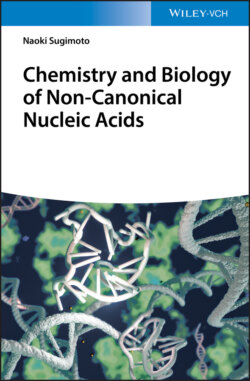Читать книгу Chemistry and Biology of Non-canonical Nucleic Acids - Naoki Sugimoto - Страница 49
3.4 Factors Influencing Stabilities of the Non-canonical Nucleic Acids 3.4.1 Factors Influencing Stability of Triplexes
ОглавлениеIt was shown that triplexes consist of two pyrimidine (Y) and one purine (R) strand (Y-R*Y, where dash and star indicate Watson–Crick and Hoogsteen base pairs, respectively) or of two purine and one pyrimidine strand (Y-R*R) (see Chapter 2) [6]. Figure 3.5 shows a typical triplex structure. The building blocks of Y-R*Y triplexes are the canonical C-G*C and T-A*T triads shown in Figure 3.5a. To form such triads, the third strand must be located in the major groove of the duplex that is forming Hoogsteen hydrogen bonds with the purine strand of the duplex (Figure 3.5a). The third strand also forms the stacking interaction with neighboring bases (Figure 3.5b), although the stacking interactions are weak relative to that in the duplex. An important feature of the Y-R*Y triplexes is that formation of the C-G*C triad requires the protonation of the N3 of cytosine in the third strand. Thus, such triplexes are favorable under acidic conditions (see next paragraph). By contrast, the Y-R*R triplexes such as T-A*A and C-G*G usually do not require protonation. The mutual orientation of the chemically homologous strands in a triplex (i.e. two pyrimidine strands in the Y-R*Y triplex or the two purine strands in the Y-R*R triplex), which a priori can be either parallel or antiparallel, is of paramount importance. In general, the stability of triplexes consisting of alternating C-G*C and T-A*T triads is higher than that of triplexes built of C-G*G and T-A*A triads under the appropriate pH due to width of major groove of the duplex. The requirement for protonation of third-strand cytosines for triplex formation makes the thermal stabilities of triple helices that include C-G*C triples sensitive to pH. For isolated C residues, this pH sensitivity is linearly dependent on the fraction of cytosines in the third strand. From the pH dependence of Tm and knowledge of the enthalpy of the transition, the number of protons released upon triplex disruption can be estimated. Generally, it was found that the number of released protons is smaller than the number of cytosines in putative C-G*C base triads. This observation could indicate partial protonation of the cytosines in the resultant single strands at low pH. Substitution of 5-methylcytosine for cytosine that is the most widely used base modification increases the stabilities of polymeric and oligomeric triplexes over a range of pH, thereby increasing the pH range in which stable triplexes are observed. As an example, an intramolecular triplex (iT)) in Figure 3.6a shows a typical melting behavior. The triplex structure exhibits typically two-melting transition at neutral or higher pH. The first and second melting transitions depend on dissociation of Hoogsteen base pairs in the third strand and Watson–Crick base pairs in the second strand, respectively. The stability of the Hoogsteen base pairs depends on the solution pH. Thus, the unfolding processes for the triplexes are different depending on the solution pH (Figure 3.6b): the Tm values for Hoogsteen base pairs are increased with decreasing solution pH, although Tm values for Watson–Crick base pairs are not significantly affected by the pH of the solution.
Figure 3.5 (a) Hydrogen bond formation in base triads in a DNA triplex. The hydrogen bonds are shown in dashed lines. (b) Triplex structures of DNAs are depicted in tube (left) and ball-and-stick (right) models, respectively. Stacking interactions are shown in arrows.
Figure 3.6 (a) Sequence for the intermolecular triplex (iT). Typical images of UV melting curves for iT in (b) various pH solutions or (c) various concentrations of Na+.
Moreover, the unfolding processes for the triplexes also depend on the cation concentration due to high charge density of triplexes (Figure 3.6c). In general, the stabilities of triplexes are much greater with divalent cations than with monovalent cations, and almost a 100-fold concentration of Na+ is required to stabilize the triplex as effectively as Mg2+ or Mn2+ [7]. It has been reported that Mg2+ is crucial for the formation of the Y-R*R triplexes than that for the formation of the Y-R*Y triplexes (Figure 3.7) [8]. The protonation at N3 of Hoogsteen cytosine residues plays a key role in stabilizing the Y-R*Y triplex structure. In contrast, the Y-R*R triplex does not require this precondition; therefore, the interaction of divalent cations with a triplex may be different for the two types of triplexes. The interaction of metal ions with the triplexes clearly depended on the type and ionic strength of the cations, and the efficiency with which the cations stabilized the global triplex was in the order Mg2+ > Mn2+ > Ca2+ > Ba2+ > Na+ (monovalent cations). This order is in good agreement with the ionic radii (r) of the divalent cations (r of Mg2+; 0.66 Å, r of Mn2+; 0.80 Å, r of Ca2+; 0.99 Å, r of Ba2+; 1.34 Å), which suggests that the divalent cations with a smaller radius may increase the affinity of the nucleotide alignment, resulting in enhancing the stability of the double helix structure. It was reported that the folding of RNA tertiary structures is also stabilized by cations and the stabilizing ability of cations to RNA depends on the ionic radius [9].
Figure 3.7 Probable structures adopted by the poly(dG)-poly(dC) sequence in supercoiled plasmid DNA and the corresponding hydrogen bonding scheme for the base triad in (a) the presence or (b) absence of 2 mM Mg2+. Hydrogen bonds in the non-B-DNA structure are shown in stars.
